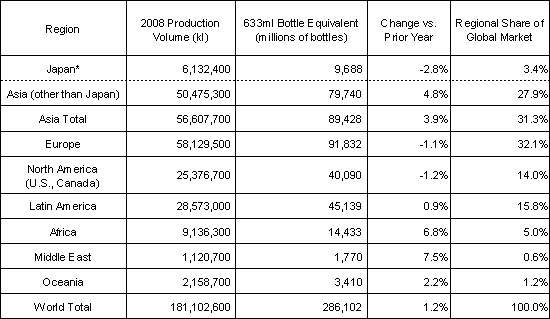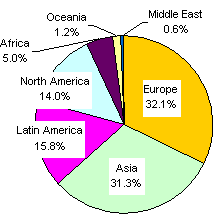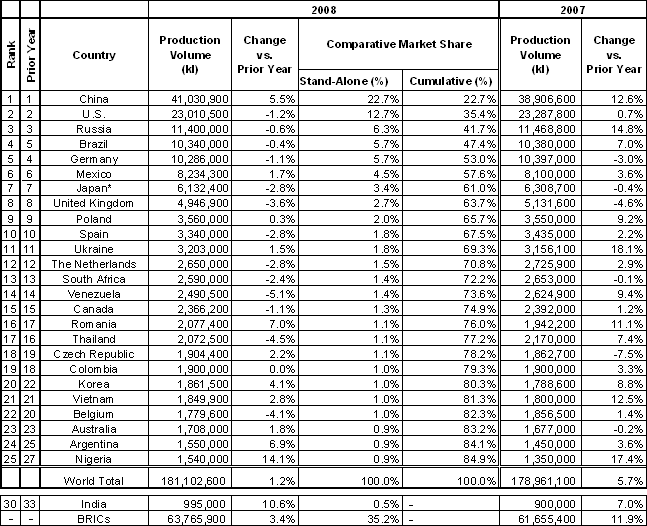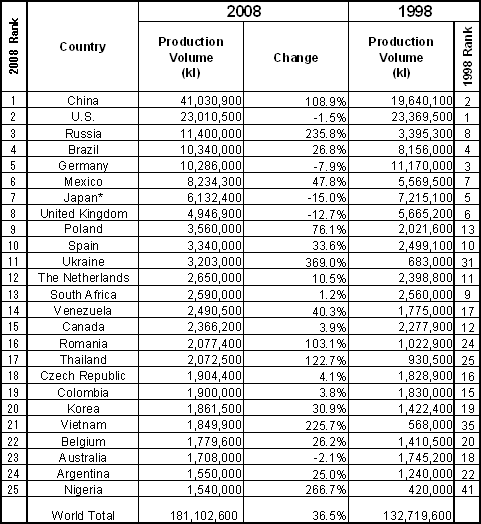![]()
August 11, 2009
Kirin Institute of Food and Lifestyle Report Vol. 18
2008 Beer Production in Major Countries
China is the world leader for the seventh consecutive year, surpassing 40 million kl
Kirin Institute of Food and Lifestyle (Kirin Holdings Company, Ltd., Kazuyasu Kato, President and CEO) has compiled its 2008 beer production report. The report summarizes statistics obtained through independent questionnaire surveys answered by the various beer associations located in the major countries around the world, as well as the latest documents available from overseas. Kirin has been using surveys to track beer production statistics since 1974.
[Summary]
- Total global beer production for 2008 was 181.10 million kl (1.2% increase over the prior year).
- A country-by-country analysis shows China (5.5% annual increase) as the number one beer-producing country for the seventh consecutive year, surpassing 40 million kl for the first time ever. Russia has appeared to lose its momentum in production (third place; 0.6% decrease), after several years of growth.
- By region, European production fell (1.1% decrease) for the first time in 12 years, while Asia (3.9% growth) increased its share of world production by 0.8 points to 31.3%, gaining on Europe, which represents the largest share (32.1%) of worldwide production.
- The BRICs countries (Brazil, Russia, India, China) produced 63.77 million kl of beer (3.4% annual increase), accounting for 35.2% of the world total. India, in particular, showed significant growth (No. 30, 10.6% increase).
Total global beer production for 2008 was 181.10 million kl, an increase of 2.14 million kl (1.2% increase) over the prior year. Since 1985, global beer production has continued to increase for 24 consecutive years.
The 2008 annual increase of 1.2% has contracted in comparison to the all-time record (5.7% increase in 2007) since statistics were first tracked beginning in 1974. The global financial crisis beginning in late 2008 appears to have had a detrimental effect on global beer markets as well.
1.Production Volume by Region (Table 1)
With the exception of Europe and North America, all regions around the world experienced production growth over the prior year.
While Europe still boasts the largest share of global production, the region experienced a 1.1% decline due to decreased production in leading European countries. Russia, which had experienced significant increases over the past several years, fell 0.6%, while Germany and United Kingdom. experienced 1.1% and 3.6% decreases, respectively.
With the contributions of global No. 1 China (5.5% increase), Korea (4.1% increase), the Philippines (No. 27 in 2008; 4.3% increase) and India (No. 30; 10.6% increase), beer production in Asia grew 3.9%, adding 0.8 points to its global share. As a result, Asia at No. 2 (31.3%) has once again closed the gap with world-leading Europe (32.1%).
Despite its relatively low volume of production, the Middle East (7.5% increase) grew the most among all regions, boosted mainly by favorable trends in Turkey (No. 31 for 2008; 7.6% increase).
2.Production Volume by Country (Table 2)
Nigeria broke into the top 25 beer-producing nations in 2008 (No. 27 in 2007). Brazil overtook Germany to claim the No. 4 spot.
Since 2002, China has been the No. 1 beer-producing country for seven consecutive years, despite experiencing only single-digit growth for the first time in four years due to the effects of soaring raw materials prices and the global financial crisis. While Russia had been demonstrating significant growth over the past several years, the nation's beer production appears to have lost its momentum, impacted by eroding consumption.
Among the leading nations, Romania (7.0% increase), Korea (4.1% increase), Argentina (6.9% increase) and Nigeria (14.1% increase) showed the highest growth rates.
Japan experienced a fourth consecutive year of declining output (2.8% decrease), affected by a low birthrate combined with an aging population, and diversification in consumer preferences.
3.Comparison to 1998 (Table 3)
Global beer production in 2008 increased by 36.5% compared to 1998. On a country-by-country basis, the 10-year comparison shows a rapid expansion in the market, with Chinese production increasing 2.1 times (No. 1 in 2008; 108.9% increase vs. 1998), Russian production increasing 3.4 times (No. 3; 235.8% increase), and Ukrainian production increasing 4.7 times (No. 11; 369.0% increase). Thailand (No. 17 in 2008; 122.7% increase vs. 1998), Vietnam (No. 21; 225.7% increase), and Nigeria (No. 25; 266.7% increase) also experienced marked growth in production volumes, raising expectations for the future with respect to emerging countries. Meanwhile, the United States of America (No. 2 in 2008; 1.5% decrease vs. 1998), Germany (No. 5; 7.9% decrease), Japan (No. 7; 15.0% decrease) and United Kingdom. (No. 8; 12.7% decrease) experienced decreased beer production levels compared to 1998, possibly indicating market maturity in these countries.
The No. 4 beer-producing nation in 1989, Japan was overtaken by Brazil in 1995, by Russia in 2002, and by Mexico in 2003, retaining the No. 7 spot ever since.
Note: Figures for Japan include the total of beer, happo-shu, and new genre production.
Source: Questionnaire survey of each country's beer associations, etc.
(conducted by Kirin Institute of Food and Lifestyle)
The Barth Report Hops 2008/2009 (BARTH—HAAS GROUP)
(Table 1) 2008 Beer Production by Region

* Figures for Japan include the total of beer, happo-shu, and new genre production.
2008 Beer Production Share by Region

- [Comments]
- All regions increased, expect Europe and North America.
- China (5.5% increase) was the main contributor to growth in Asia, increasing the Asian share of the global market by 0.8 points compared to the prior year.
- Europe, the largest producer in the world, experienced a decline in production for the first time in 12 years, due to declines in Russia (0.6% decrease), which had experienced several years of major growth, Germany (1.1% decrease) and United Kingdom. (3.6% decrease).
(Table 2) 2008 Beer Production by Country
* Figures for Japan include the total of beer, happo-shu, and new genre production.

- [Comments]
- China, maintaining the top rank for seven consecutive years since overtaking the United States in 2002, produced more than 40 million kl of beer in 2008, opening an 18.02 million kl gap with the U.S. With an expanding beverage market driven by increasing personal income and living standard levels associated with economic advancement, beer production is expected to continue to grow in China. However, 2008 growth in China was only 5.5% due to the influence of soaring raw materials prices and the global financial crisis, marking the first time in four years that growth in this market was limited to single digits.
- Despite experiencing several years of major growth in beer production volume and reaching No. 3 in global production in 2007, Russian production appears to lose its momentum, falling 0.6% for 2008. The decrease is likely due to the eroding consumption levels.
- In Latin America, BRICs cornerstone Brazil overtook Germany to become the world's No. 4 beer producer. Brazil continues to experience growth underpinned by favorable domestic consumption and a stable economy; however, Brazilian beer production declined 0.4% for 2008.
- Nigeria marked the highest growth among the top 25 beer-producing nations (14.1% increase), followed by Romania (7.0% increase), Argentina (6.9% increase) and China (5.5% increase).
- Japan experienced declining output (2.8% decrease) due to a low birthrate combined with an aging population, and diversification in consumer preferences.
(Table 3) 2008 Beer Production by Country vs. 1998

* Figures for Japan include the total of beer, happo-shu, and new genre production.
- [Comments]
- 2008 global beer production experienced a 36.5% increase compared to 1998 levels.
- Compared to 1998, China grew 2.1 times, Russia grew 3.4 times, and the Ukraine grew 4.7 times. Romania, Thailand, Vietnam and Nigeria also demonstrated high comparative growth.
